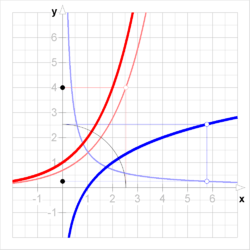Inverse functions and differentiation

Example for arbitrary :
In mathematics, the inverse of a function is a function that, in some fashion, "undoes" the effect of (see inverse function for a formal and detailed definition). The inverse of is denoted . The statements y = f(x) and x = f −1(y) are equivalent.
Their two derivatives, assuming they exist, are reciprocal, as the Leibniz notation suggests; that is:
This is a direct consequence of the chain rule, since
and the derivative of with respect to is 1.
Writing explicitly the dependence of on and the point at which the differentiation takes place and using Lagrange's notation, the formula for the derivative of the inverse becomes
Geometrically, a function and inverse function have graphs that are reflections, in the line y = x. This reflection operation turns the gradient of any line into its reciprocal.
Assuming that has an inverse in a neighbourhood of and that its derivative at that point is non-zero, its inverse is guaranteed to be differentiable at and have a derivative given by the above formula.
Examples
- (for positive ) has inverse .
At x = 0, however, there is a problem: the graph of the square root function becomes vertical, corresponding to a horizontal tangent for the square function.
- (for real ) has inverse (for positive )
Additional properties
- Integrating this relationship gives
- This is only useful if the integral exists. In particular we need to be non-zero across the range of integration.
- It follows that a function that has a continuous derivative has an inverse in a neighbourhood of every point where the derivative is non-zero. This need not be true if the derivative is not continuous.
Higher derivatives
The chain rule given above is obtained by differentiating the identity x = f −1(f(x)) with respect to x. One can continue the same process for higher derivatives. Differentiating the identity twice with respect to x , one obtains
that is simplified further by the chain rule as
Replacing the first derivative, using the identity obtained earlier, we get
Similarly for the third derivative:
or using the formula for the second derivative,
These formulas are generalized by the Faà di Bruno's formula.
These formulas can also be written using Lagrange's notation. If f and g are inverses, then
Example
- has the inverse . Using the formula for the second derivative of the inverse function,
so that
- ,
which agrees with the direct calculation.
See also
- Calculus
- Inverse functions
- Chain rule
- Inverse function theorem
- Implicit function theorem
- Integration of inverse functions
